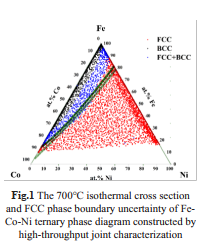Micro-beam High-throughput XRD+XRF Characterization and Phase Boundary Uncertainty Analysis of Combinatorial Materials Chip
Zongqiang Feng, Rui Fu, Chengwei Lin, Zhoujie Lao, Han Yang, Zijin Wang, Tianlin Huang, Guilin Wu, Xiaoxu Huang*
Chongqing University,Chongqing, 400044
EXTENDED ABSTRACT: The combinatorial materials chip sample prepared by the continuous mask method has good linearity in composition, and can cover the entire composition range of the ternary alloy system. It has been proven to be powerful to construct the isothermal section of the ternary phase diagram [1]. However, limited by experimental samples and characterization techniques, the past experimental methods used a couple of hundreds of data points, and was easy to miss the phase distribution information in the binary phase boundary area [2]. In order to give full play to the advantages of the combinatorial materials chip, we designed and built a comprehensive characterization chamber that can simultaneously collect X-ray diffraction and fluorescence signals. Combined with the synchrotron radiation X-ray focused by the KB mirror at SSRF, the joint characterization of a single sample with 5000-point microbeam high-throughput XRD+XRF was realized. In this paper, a newly designed "Chip 2.0" sample was used, which included unary area, binary area and ternary area at the same time.
The diffraction and fluorescence data of the Fe-Co-Ni ternary system collected in the experiment were processed, and the isothermal section of the ternary phase diagram with 5000 data points was constructed through automatic phase classification and element analysis, as shown in the right figure. The adjustment of the characterization range makes more data points fall in the Fe-Co and Fe-Ni binary regions, and the binary boundary is clearer. The reduction in beam spot size and the increase in the number of characterization points make the phase boundary smoother and more complete. Compared with the characterization density of the order of 102, the characterization density of 5000 points for a single sample significantly reduces the uncertainty of the phase boundary.

REFERENCES
[1] Hui Xing, Bingbing Zhao, Yujie Wang, Xiaoyi Zhang, Yang Ren, Ningning Yan, Tieren Gao, Jindong Li, Lanting Zhang, and Hong Wang. ACS Combinatorial Science 2018 20 (3), 127-131.
[2] Zhaoyang Zhao, Ying Jin, Peng Shi, Yanpeng Xue, Bingbing Zhao, Yanpeng Zhang, Feifei Huang, Peng Bi, and Qingrui Wang. ACS
Combinatorial Science 2019 21 (12), 833-842.

Lanting Zhang is currently a Professor of Materials Science & Engineering at Shanghai Jiao Tong University (SJTU) and Deputy Director of the Materials Genome Initiative Center (MaGIC) of SJTU. He is also the group leader of the High Performance Metallic Materials Laboratory in School of Materials Science and Engineering (SMSE). He received his BSc, MSc and Ph.D. in materials science from SJTU in 1991, 1994 and 1997 respectively. His current research interests include high-throughput characterization of materials, development
of rare-earth permanent magnetic materials for traction motor and heat-resistant steels for turbine and ultra-super critical power plant etc. He is now leading a National Key Research and Development Program project on high-throughput characterization of materials combinatorial chips. He has published over 90 peer-reviewed journal articles in Acta Materialia, Scripta Materialia, PRB, JAP, Intermetallics and JALCOM etc.